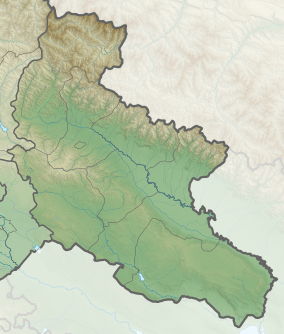Pankisi
Pankisi (პანკისი) or the Pankisi Gorge (Georgian: პანკისის ხეობა, Pankisis Kheoba) is a valley region in Georgia, in the upper reaches of River Alazani just south of Georgia’s historic region of Tusheti between Mt Borbalo and the ruined 17th-century fortress of Bakhtrioni. Administratively, it is included in the Akhmeta municipality of the Kakheti region. An ethnic group called Kists of Chechen roots form the majority (75%) in the area.
| Pankisi Gorge | |
|---|---|
| Georgian: პანკისის ხეობა | |
 Pankisi Gorge  Pankisi Gorge | |
| Geography | |
| Country | |
| Coordinates | 42°07′N 45°16′E |
Area conditions

It had allegedly often been used as a base for transit, training and shipments of arms and financing by Chechen rebels and Islamic militants, including foreign fighters, many of whom followed Ruslan Gelayev.[1] Most of these accusations were around 2002, but others allege that it is more peaceful now,[2] although there are still many Chechen refugees living there.[3] The senior ISIS leader "Omar the Chechen" grew up in the area, where his family still lives,[4] and in 2014 Omar reportedly threatened to return to the area to lead a Muslim attack on Russian Chechnya.[5]
Cultural references
The situation in the Pankisi Gorge received an extensive fictional treatment factoring into several of the popular John Ringo anti-terrorism military science fiction books in the Paladin of Shadows series.
Notes
- Kleveman, Lutz, 'The New Great Game', Grove Press New York, 2003 page 35; sourced from New York Times August 15, 2002.
- BBC News, Russia's reach unnerves Chechens, Wednesday, 16 January 2008. http://news.bbc.co.uk/2/hi/europe/7189024.stm Retrieved September 29, 2010.
- UNHCR, 'Chechen refugees in Pankisi Gorge resume normal life after Georgia scare', 1 October 2008. http://www.unhcr.org/48e389e12.html Retrieved September 29, 2010.
- Akhmeteli, Nina (2014-07-09). "Georgian roots of Isis commander". BBC News.
- "Bloomberg - Are you a robot?".
References
- Shorena Kurtsikidze & Vakhtang Chikovani, Ethnography and Folklore of the Georgia-Chechnya Border: Images, Customs, Myths & Folk Tales of the Peripheries, Munich: Lincom Europa, 2008.
External links
- Shorena Kurtsikidze and Vakhtang Chikovani, Georgia's Pankisi Gorge: An Ethnographic Survey, Berkeley Program in Soviet and Post-Soviet Studies,University of California, Berkeley, Spring 2002.(http://escholarship.org/uc/item/64d7v9hj)
- Rebecca Ruth Gould, “Secularism and Belief in Georgia’s Pankisi Gorge," Journal of Islamic Studies 22.3(2011): 339–373.
- Georgia Sustainment and Stability Operations Program